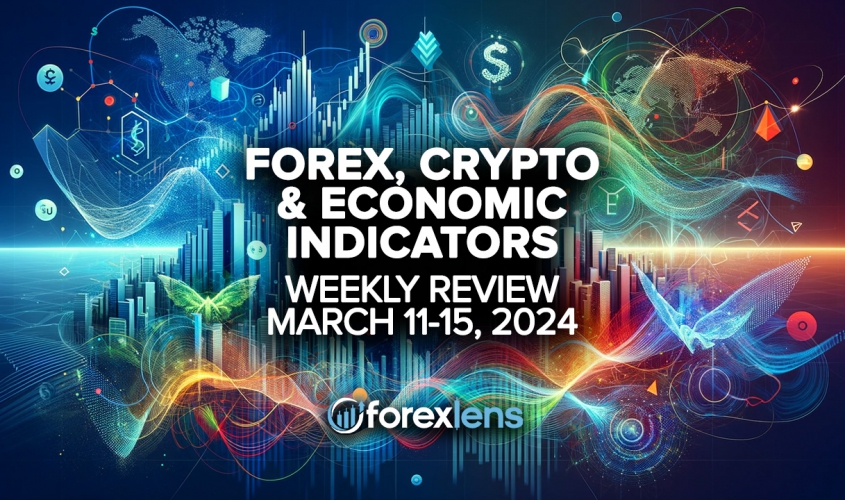This past week’s economic events have been influential across various financial markets, including the forex and cryptocurrency sectors. Let’s break down how these events and how they have influenced the U.S. Dollar Index (USDX) and could potentially affect major forex and crypto pairs in both the short and long term.
U.S. Dollar Index (USDX)
- The USDX showed fluctuations throughout the week, with a notable increase on 03/14/2024, rising by +0.58%. This uptick can be attributed to stronger-than-expected U.S. economic data, specifically the CPI and Retail Sales data, which showed resilience in the U.S. economy. This kind of data tends to bolster the USDX as it could imply potential interest rate hikes or sustained monetary policy tightening by the Federal Reserve.
- Towards the end of the week, on 03/15/2024, the USDX experienced a slight increase of +0.06%, possibly due to mixed economic indicators and market sentiments around global economic conditions and U.S. economic strength.
Forex Market
EUR/USD
The Eurogroup and ECOFIN meetings, along with various European economic data releases, would typically influence the EUR/USD pair. Given the mixed economic indicators from Europe, including the German WPI and Italian industrial figures, the EUR might have experienced pressure against the USD, especially as U.S. economic data came out strong.
GBP/USD
The British Pound might have faced volatility against the USD due to several key economic releases, including employment figures, GDP, and manufacturing data. The speech by BOE Governor Bailey and MPC Member Mann could have also introduced volatility. With the UK showing mixed economic performances, the GBP’s strength against the USD would be contingent on relative economic outlooks and interest rate differentials.
AUD/USD
Australian economic events, notably the speeches by RBA officials and NAB Business Confidence, could influence the AUD. However, given the stronger USD backdrop, the AUD may have struggled to make significant gains against the USD unless Australian data strongly outperformed expectations.
USD/JPY
Japanese economic data, including the Prelim Machine Tool Orders and BSI Manufacturing Index, showed some weaknesses in the Japanese economy. The USD/JPY pair might have been influenced by these releases, with the USD gaining against the JPY, especially if investors flock to the USD as a safe haven amidst uncertainties in other markets.
Short-Term Cryptocurrency Market Dynamics
The cryptocurrency market experienced significant volatility during the week, with notable price swings and volume changes. For instance, the market saw a decrease from a high of $72,339.55 on March 15, 2024, to a close of $68,342.41, following a pattern of fluctuations throughout the week. This volatility can be attributed to a variety of factors, including reactions to the USDX fluctuations and global economic indicators.
March 10-11, 2024
The cryptocurrency market showed resilience with a rise in Bitcoin’s price, possibly as a reaction to economic uncertainties and as an alternative investment amidst fluctuating forex markets and the relatively stable yet slightly declining USDX.
March 12-14, 2024
The market experienced notable highs and lows, potentially influenced by the US economic data releases (such as CPI, Retail Sales, and PPI) that also impacted the USDX. The strong U.S. economic data might have led investors to pivot towards traditional assets, impacting cryptocurrencies’ appeal temporarily.
March 15, 2024
The decline in Bitcoin’s price could reflect a consolidation after the week’s earlier volatility or a reaction to the slight increase in the USDX, as a stronger dollar can make cryptocurrencies less attractive to investors holding USD.
Long-Term Effects
USDX
In the long term, the strength of the USDX will depend on the Federal Reserve’s monetary policy direction, economic recovery pace, and global market sentiment. Sustained positive economic data from the U.S. could support a stronger USDX.
Forex Pairs
For major forex pairs, interest rate differentials, economic recovery trajectories, and geopolitical events will play critical roles. The long-term impact on these pairs will depend on how economies adapt to post-pandemic conditions, inflation, and changes in trade relations.
Cryptocurrencies
Correlation with Traditional Markets
While cryptocurrencies can sometimes act as a hedge against traditional market movements, they can also react negatively to a stronger USD and positive US economic indicators, as seen in the short-term reactions this week. Cryptocurrencies may continue to experience volatility from macroeconomic indicators, regulatory news, and shifts in investor sentiment towards risk. Long-term trends will likely be influenced by broader adoption, technological advancements, and regulatory clarity.
Diversification and Institutional Interest
The increasing interest of institutional investors in cryptocurrencies could contribute to market stability and growth over time. As traditional financial institutions continue to integrate cryptocurrencies into their portfolios, this is leading to greater liquidity and reduced volatility, potentially making cryptocurrencies a more attractive investment in the context of global economic shifts.
Analyzing the week’s fundamental events and historical data, it’s clear that economic indicators, central bank communications, and global economic conditions have a significant impact on the forex and crypto markets, shaping both short-term fluctuations and long-term trends.



